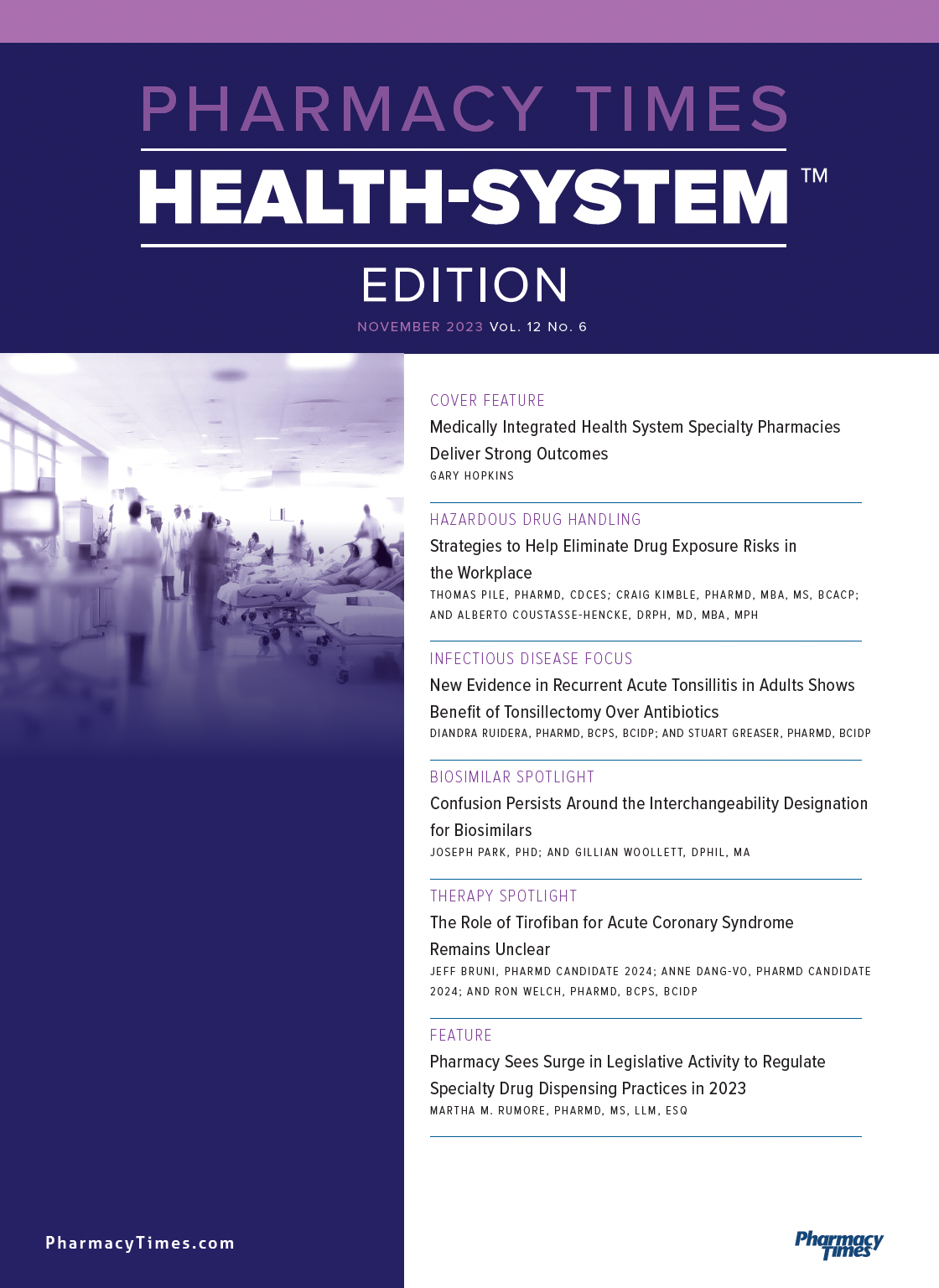Publication
Article
Pharmacy Practice in Focus: Health Systems
Strategies to Help Eliminate Drug Exposure Risks in the Workplace
Author(s):
Safe handling of hazardous drugs plays a vital role in patient care.
Ensuring the safe handling of hazardous drugs (HDs) has been a top priority in health care settings. The American Society of Health-System Pharmacists (ASHP) has continually updated guidelines and standards to guide pharmacists in safely handling HDs. In 2006, ASHP released its most recent guidelines on handling hazardous drugs, aligning its recommendations with the National Institute for Occupational Safety and Health (NIOSH) alert issued in 2004.1 In 2007, United States Pharmacopeia (USP) General Chapter <797> also updated its requirements to align with the NIOSH 2004 alert.2 Standards from USP General Chapter <800>, released in 2016 and subsequently updated, include best practice recommendations and mandates regarding handling hazardous drugs.3
The Occupational Safety and Health Administration has recognized that exposure to HDs has become of increasing concern and emphasizes how employer programs should follow guidelines established by USP General Chapters <797> and <800>.4 Furthermore, USP General Chapter <800> provides standards for the safe handling of HDs to minimize risk of exposure. These guidelines for handling HDs supply a systematic approach to ensure safety at every stage of the drug-handling process. In addition, NIOSH has maintained a readily accessible HD list, guidelines for HD risk assessment, and guidelines for personal protective equipment (PPE).5
Image credit: Seventyfour | stock.adobe.com

Hazardous Drug Assessment
Maintaining an up-to-date list, including drug names (eg, cisplatin), dosage forms, and handling requirements, is critical to identifying all HDs used. NIOSH has maintained a comprehensive list that is readily accessible, providing a foundation for a health care organization’s own list of HDs.5 An organization must maintain a list of all HDs in its inventory, including items on the NIOSH list, and review it at least every 12 months.3 Using a multidisciplinary committee to review the list of HDs can facilitate communication between departments, create engagement, and ensure completion of action items.6 Additionally, NIOSH has a procedural document for health systems to follow in examining new drugs for their HD list.7
Personnel Training and Education
Comprehensive training is crucial for all personnel involved in handling HDs. Initial and ongoing training related to hospital-approved education is required for all staff on the medication circuit, including safe handling and spill or leak management.3 Training should encompass safe handling procedures, PPE usage, and spill response.8
Engineering Control
To minimize airborne exposure during drug preparation, implement appropriate engineering controls, such as biological safety cabinets, compounding aseptic isolators, and ventilated containment devices as found in many health system pharmacies.9-11 Regular maintenance and certification of these controls are vital to ensure their effectiveness. Staff should ensure vials have been cleaned before they are stored in HD work areas, as residue may be present outside of vials received from manufacturers or distributors.9
PPE
Training personnel in the correct use and disposal of PPE is essential. NIOSH has instructions on using PPE based on product formulation, activity, and specific engineering control requirements.5 For example, glove requirements vary significantly based on activity and drug classification. During the administration of HDs, if an antineoplastic HD is being administered, 2 pairs of chemotherapy gloves must be worn; while administering other HDs, the PPE requirement should be specifically outlined in the entity’s policy.5
Safe Handling Procedures
Establishing a set of protocols to govern the handling of HDs is of utmost importance. These protocols should encompass comprehensive guidelines for compounding, labeling, and administration, with the aim of reducing contamination risk.11 Adherence to such protocols is crucial for ensuring the safety of employees, patients, and the public. All personnel involved in the handling of HDs should remain vigilant and strictly follow these guidelines.
Additionally, signage must be prominently displayed before the entrance of HD handling areas and be available to restrict access to areas where HD spills occur.3 Further, spill kits should be maintained with the appropriate materials for an immediate response, and regular drills should be conducted to ensure staff are proficient in spill management. HD waste should be segregated and disposed of in accordance with regulations and guidelines, and proper labeling and handling of waste containers should be ensured to prevent contamination.
Environmental Monitoring
Regularly monitoring the pharmacy environment for contamination remains key. Air and surface sampling can help identify potential exposure risks and guide corrective actions, as air samples have been shown to contain hazardous material.10 Atypical areas, such as intravenous poles and pharmacy transport bins, have also been found to be contaminated in some pharmacies.12 Lastly, it is important to ensure best practices of periodic cleaning to cover these areas to help ensure safety from exposure.13
Conclusion
Pharmacists, as health care providers, prioritize the safety and welfare of all individuals under their care. They achieve this by strictly adhering to best practices that minimize potential harm to health care workers and patients while ensuring the efficacy of drug treatments. Handling HDs is not only a matter of adherence but also a testament to a shared commitment to the health and well-being of the community. Pharmacists’ unrelenting commitment to outstanding health care is exemplified through these persistent safety endeavors that help to enhance and protect lives.
References
1. Power LA, Coyne JW. ASHP guidelines on handling hazardous drugs. Am J Health Syst Pharm. 2018;75(24):1996-2031. doi:10.2146/ajhp180564
2. United States Pharmacopeial Convention. Pharmaceutical compounding – sterile preparations. United States Pharmacopeia. Updated November 1, 2022. Accessed October 17, 2023. https://www.usp.org/compounding/general-chapter-797
3. United States Pharmacopeial Convention. Hazardous drugs—handling in healthcare settings. United States Pharmacopeia. Updated June 26, 2020. Accessed October 17, 2023. https://www.usp.org/compounding/general-chapter-hazardous-drugs-handling-healthcare
4. Work precautions for handling hazardous drugs highlighted by NIOSH, OSHA, Joint Commission. News release. US Department of Labor. April 7, 2011. Accessed September 12, 2023. https://www.osha.gov/news/newsreleases/trade/04072011
5. Connor TH, MacKenzie BA, DeBord DG, Trout DB, O’Callaghan JP. NIOSH list of antineoplastic and other hazardous drugs in healthcare settings, 2016. CDC. September 2016. Accessed September 12, 2023. https://www.cdc.gov/niosh/docs/2016-161/pdfs/2016-161.pdf?id=10.26616/NIOSHPUB2016161
6. Wrzesniewski CE, Park HK. Leveraging a multidisciplinary oversight committee to ensure USP <797> and <800> compliance at a Veterans Affairs health system. Am J Health Syst Pharm. 2022;79(4):276-282. doi:10.1093/ajhp/zxab412
7. Whittaker C, Ovesen JL, MacKenzie BA, Hartley T, Berry KA, Piacentino J. Procedures for developing the NIOSH list of hazardous drugs in healthcare settings. CDC. April 2023. Accessed September 17, 2023. https://www.cdc.gov/niosh/docs/2023-129/2023-129.pdf?id=10.26616/NIOSHPUB2023129
8. Hazard communication. 29 CFR §1910.1200 (2013). Cornell Law School. Accessed September 17, 2023. https://www.law.cornell.edu/cfr/text/29/1910.1200
9. Power LA, Sessink PJ, Gesy K, Charbonneau F. Hazardous drug residue on exterior vial surfaces: evaluation of a commercial manufacturing process. Hosp Pharm. 2014;49(4):355-362. doi:10.1310/hpj4904-355
10. Sessink PJ, Leclercq GM, Wouters DM, Halbardier L, Hammad C, Kassoul N. Environmental contamination, product contamination and workers exposure using a robotic system for antineoplastic drug preparation. J Oncol Pharm Pract. 2015;21(2):118-127. doi:10.1177/1078155214522840
11. Pile T, Kimble C, Coustasse-Hencke A. Navigating the path to safe compounding in health systems. Pharmacy Times. Published online July 14, 2023. Accessed September 17, 2023. https://www.pharmacytimes.com/view/navigating-the-path-to-safe-compounding-in-health-systems
12. Eisenberg S. Sequential wipe testing for hazardous drugs: a quality improvement project. Clin J Oncol Nurs. 2023;27(3):267-273. doi:10.1188/23.CJON.267-273
13. Hon CY. Side-by-side comparison of methods for environmental monitoring for hazardous drug contamination. Can J Hosp Pharm. 2023;76(2):87-93.doi:10.4212/cjhp.3275
About the Authors
Thomas Pile, PharmD, CDCES, is a clinical assistant professor in the Department of Pharmacy Practice, Administration, and Research at Marshall University School of Pharmacy in Huntington, West Virginia.
Craig Kimble, PharmD, MBA, MS, BCACP, is director of experiential learning, manager of clinical support services, and associate professor of pharmacy practice, administration, and research at Marshall University School of Pharmacy in Huntington, West Virginia.
Alberto Coustasse, DrPH, MD, MBA, MPH, is the director of the Health Informatics Program in the Management and Healthcare Administration Division at the Lewis College of Business at Marshall University in South Charleston, West Virginia.

Newsletter
Stay informed on drug updates, treatment guidelines, and pharmacy practice trends—subscribe to Pharmacy Times for weekly clinical insights.






